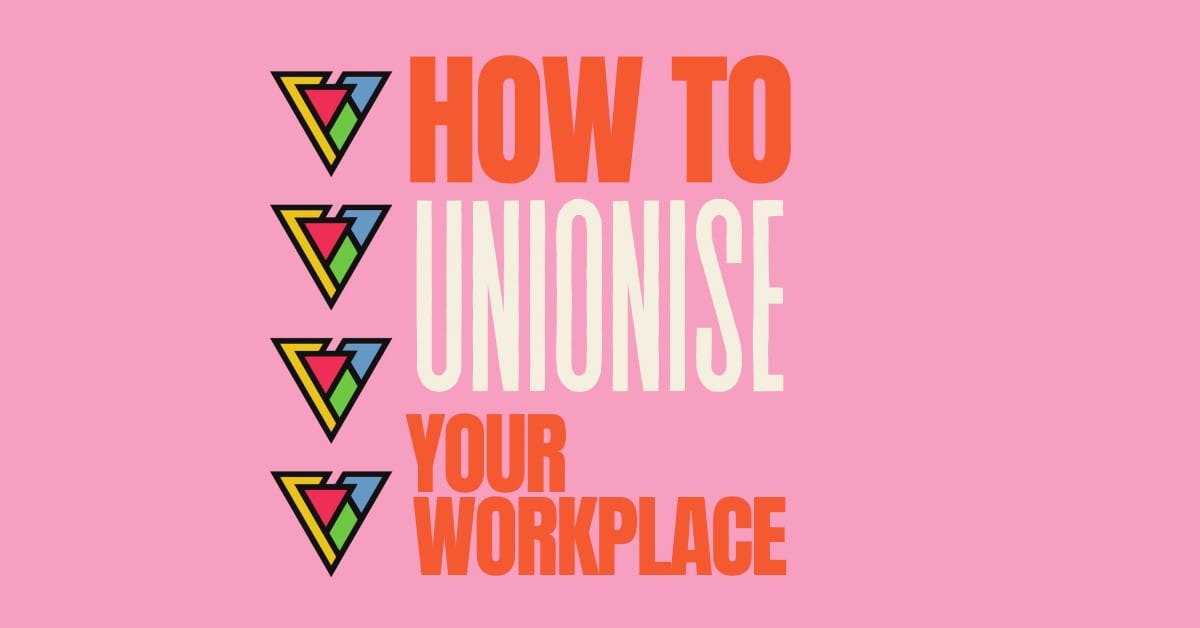How to unionise your workplace
A beginner’s guide to workplace organising.

Over the past month, as many as 1.5 million workers are thought to have taken strike action across the UK. From nurses and ambulance staff to posties and railway workers – with civil servants, firefighters and teachers expected to follow suit – ordinary people up and down the country are showing that they’re fed up with the raw deal they’ve been getting from their employers for too long, and are using their collective power to bargain for the salaries and working conditions that will allow them to live with dignity. Public support for the striking workers during this ‘winter of discontent’ has held pretty high despite relentless attacks by right-wing journalists in print and on TV, and we’ve even seen some Jewish solidarity on the picket lines in recent weeks.
Strikes like these don’t happen overnight; they are the result of strategic organising and tactical escalation over extended periods of time – a feat usually made possible by unions or other democratic forms of workplace organisation, and something the Tory government intends to make more difficult with the introduction of anti-strike legislation later this week. Deciding to withdraw labour en masse is only one of a plethora of means of collective action that workers can take to force their employers to concede to their demands. But for many people, especially those of us working in industries with low union density, labour organising can be a bit of a mystery. Today, not even a quarter of British workers are unionised, and that rate has dropped some 10% over the past two and a half decades.
This week’s Pickle is the first in a three-part series for the new year on unions and labour organising, and we’re starting with the basics. Ian Allinson, author of the recently published Workers Can Win! A Guide to Organising At Work, has put together a step-by-step explainer to help you understand why labour organising is so important and, most importantly, how you can do it successfully. Go get organised▼
Ben Reiff
Workplace organising 101
by Ian Allison
With soaring prices leaving incomes behind, increasing numbers of workers are seeing collective action as the only realistic way to defend our livelihoods. Job hopping may help some workers in the short term, but employers’ race to the bottom means that the problem tends to follow us wherever we go. The cost-of-living crisis and the sight of unions standing up to greedy employers and a vicious government are making more people – many of them inspired by Corbynism, or active in movements against social injustice, climate breakdown or rising imperialist tensions – consider organising at work for the first time.
After decades of passivity in the workers’ movement in Britain, most workers today have limited experience of organising. Those who do want to organise their workplaces struggle to access guidance that can help them. Union membership is concentrated in the public sector, privatised public services, and a few other pockets. Even where there is a union, it isn’t always effective. Union staff are often run off their feet trying to support existing members.
It is in this context that Pluto Press have published my book, Workers Can Win! A Guide to Organising At Work, and in which the bakers’ union (BFAWU) and others have launched Organise Now!, offering a quick initial response to workers wanting to organise. So how exactly do you organise your workplace?
What is organising?
Organising can mean many things. I use it to mean systematically building workers’ power: our collective ability to achieve the outcomes we want, despite any opposition from employers, government or others. So it isn’t simply about union membership. There are plenty of workplaces with union members who don’t stick together. Equally, there are examples like the recent sit-in strikes at Amazon warehouses in Britain, where workers aren’t in unions but take powerful collective action. However, workers can’t sustain the capacity for collective action over long periods or involving large numbers of workers without structured and democratic organisation, which is what a union can offer.
Getting started
While there can be situations where you have to take a stand as a matter of principle despite big risks, these are exceptional. Generally, you need to keep yourself safe: once you start organising, you will have a target on your back, so give your employer no excuses for disciplinary action.
When you are aggrieved at something your employer has done, it’s nearly always better to discuss it with your workmates and do something collective rather than mouthing off at managers. Power comes from workers sticking together, not from individual heroics. Try to be one step ahead of your workmates, not one hundred, and not none. If you aren’t ahead at all, you aren’t offering them guidance or leadership. If you are too far ahead then they won’t see the relevance of what you are saying and you aren’t helping them take the next step. Instead, you leave yourself vulnerable to victimisation.
Power comes from workers sticking together, not from individual heroics.
As soon as you can, find some trusted allies. The first step is to get people talking. Once people are chatting, maybe you can mention one of the strikes in the news and see how people react. Above all – listen! What issues concern people? Who puts forward management lines? Who talks before engaging their brain? Which workers do colleagues trust and respect?
Gather information about your employer, its policies and the workforce. For many organisations, you can download accounts from Companies House. You can set up alerts for media coverage of your employer, and search for court cases they have been involved in. Being familiar with your employer’s policies will help you understand issues colleagues may face and make you someone people go to for advice. Knowing about the workforce – including those who may be based elsewhere, subcontracted, or work out of hours – can help you plan organising efforts and assess your progress.
If you aren’t yet in a union yourself, pick one to join. There is a tendency to choose one whose leaders or policies we like. This is generally a mistake. If some of your colleagues are already in a union, it is nearly always best to join that one. If not, look for a union that organises workplaces like yours. The Trades Union Congress (TUC) is the main umbrella organisation for unions in Britain and has a useful guide covering affiliated unions, but not all are. Identify a few potential unions, then call them and ask what relevant membership or organisation they already have, or how they can help you organise.
Choose issues to organise around
As you listen to other workers, you will begin to find out what matters to them. While you may end up tackling other issues in other ways, the best issues to organise around are widely felt, deeply felt, winnable and visible. This means that a big proportion of the team, department or wider workforce feel strongly about that issue, that you have (or can build) enough power to win on the issue, and that success will be visible and memorable to workers rather than confidential or irrelevant to their daily lives. You could make a big list of issues in your workplace and score them against these four criteria.
Follow an organising cycle (issue – organisation – education – action) on each issue, building power each time you repeat it. Some issues may require more than one cycle before you win. The ‘issue’ stage is about identifying the issue. ‘Organisation’ is about establishing teams, committees, communication channels etc. and using them to engage people about the issue. You can make a chart listing the workers to track their support and involvement. ‘Education’ improves workers’ knowledge about how union organising can help achieve their goals and how you plan to win. The ‘action’ stage involves one or more collective actions.
A vital part of the process is the one-to-one organising conversation, for which you can download a guide here.
Take collective action
Collective action isn’t just strikes – there are many options including petitions, everyone wearing a sticker, demonstrations, strikes and other forms of direct action. Come up with lots of ideas for your campaign and rank them in order of how risky they might feel to workers, to help you choose appropriate tactics for different stages of your campaign.
Think about who has the power to decide to give you what you want. Then you can estimate what it would cost them to make that concession. This “concession cost” isn’t just financial. For example, decision-makers can worry about setting a precedent, reputational damage, or feel that conceding violates their principles or values. To make them concede to your demands, you need to threaten a ‘disruption cost’ greater than the concession cost. Sometimes just threatening collective action is enough, but you may have to take some action to establish the credibility of your threat – your capacity and willingness to carry it out.
To make them concede to your demands, you need to threaten a ‘disruption cost’ greater than the concession cost.
Disruption already inflicted doesn’t count towards your disruption cost. The decision maker can no longer avoid it, so it is no longer a threat. That’s one reason why campaigns often ‘escalate’ the disruptiveness of collective action until the decision-makers are convinced of the credibility of the threat of further action.
The time to organise is now
After decades in which powerful collective action was rarely seen in the British workplace, workers are having to learn afresh how to organise effectively and fight back. With a cost-of-living crisis, an approaching recession, and an accelerating climate crisis, this is urgent. Nobody can do it for us – we have to do it ourselves▼
Ian Allinson is a longtime workplace activist and the author of Workers Can Win! A Guide to Organising At Work.




